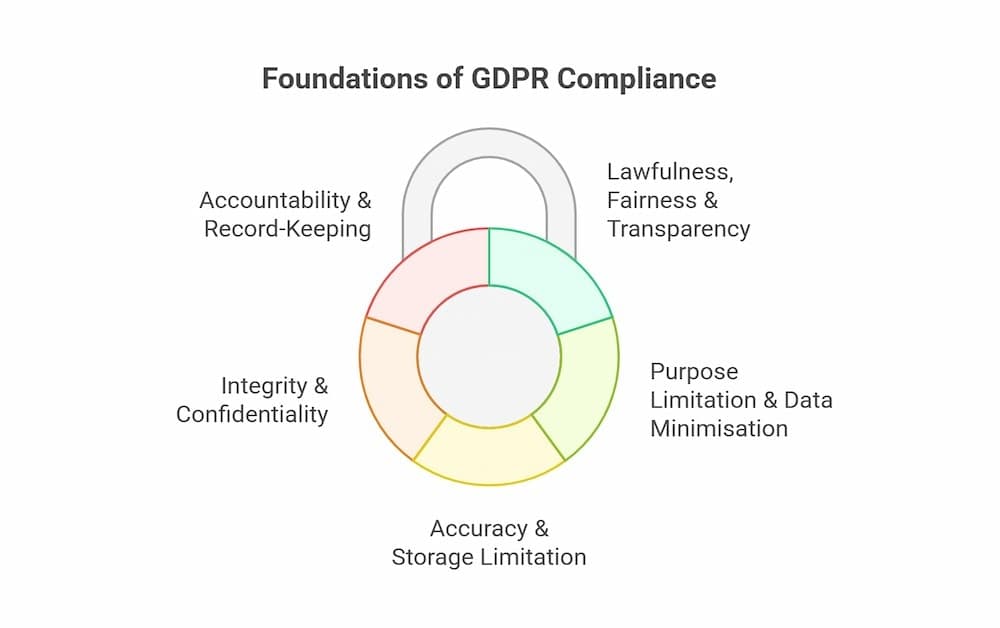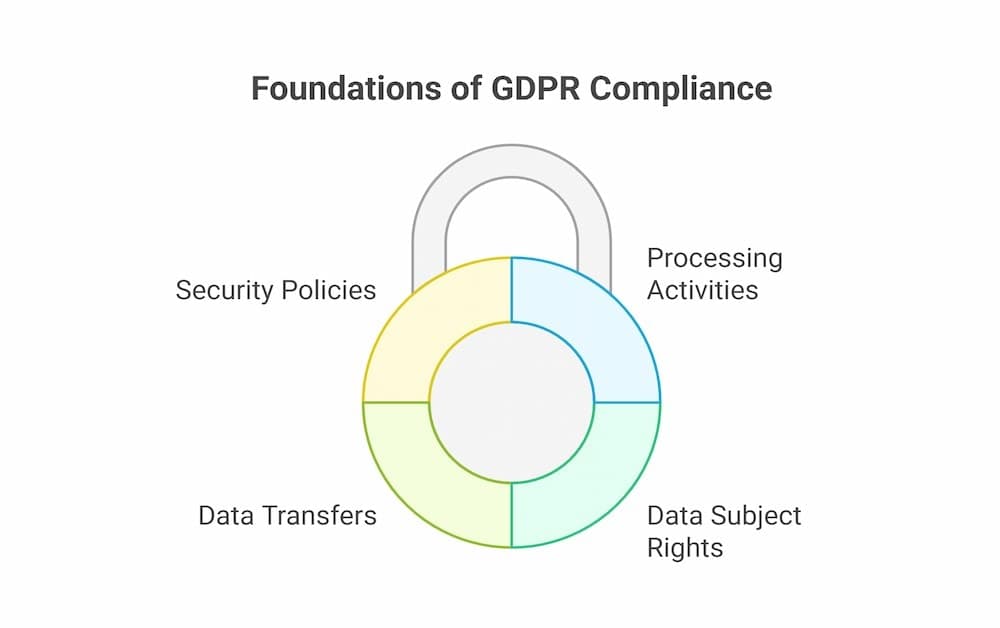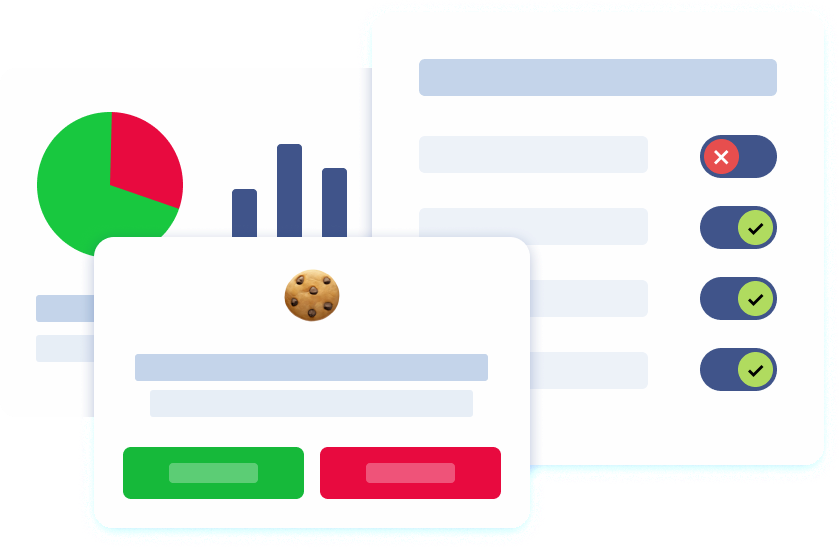Introduction
The General Data Protection Regulation (GDPR) stands as the cornerstone of contemporary data protection in the European Union, covering all entities that process personal data of EU citizens. Since it took effect in May 2018, this new data protection law has had a sweeping impact on organizations worldwide. GDPR applies not only to EU-based organizations but also to non-EU businesses, such as those in the UK, US, and UAE, whenever they process personal data of EU citizens or transfer such data internationally. The regulation sets strict guidelines around data processing activities, personal data protection, and the fundamental rights of data subjects. Penalties for data breaches or unlawful processing can reach into the tens of millions of euros, underscoring the high stakes for compliance. GDPR’s global reach has also influenced privacy laws in other countries, with many nations adopting or considering similar regulatory frameworks.
Under GDPR, businesses—whether recognized as data controllers or data processors—must uphold data protection principles such as transparency, data minimisation, accuracy, and accountability. Obligations extend to implementing security measures, maintaining gdpr compliance through data protection policy, and appointing a Data Protection Officer (DPO) where legally required. To help organizations navigate GDPR’s intricacies, the European Data Protection Board (EDPB) provides ongoing guidance and interpretation.
Despite its comprehensive scope, GDPR has proven especially burdensome for small business and smaller businesses, including UK businesses post-Brexit and SMEs that struggle with its regulatory weight. Recognizing these challenges, the EU recently launched a series of reforms aimed at simplifying GDPR and reducing the administrative costs of compliance.
Key Principles of GDPR
GDPR is founded on several core rules that define legitimate data processing activities. Under GDPR, a data controller is the entity that decides how and why personal data is processed, whereas a data processor handles personal data on the controller’s behalf. Both have specific responsibilities, including ensuring data protection by design, appointing a Data Protection Officer where required, and handling data subject rights.
- Lawfulness, fairness & transparency
All data collection must be based on a valid legal basis (e.g., consent, vital interests, or public interest), handled fairly, and communicated in clear and plain language. - Purpose limitation and data minimisation
Organizations that process personal data should do so only for specified, explicit purposes and must limit data to what is strictly necessary. - Accuracy and storage limitation
Data subjects’ rights to rectification and erasure ensure that customer data, and such data, remains current and is deleted once no longer needed. - Integrity and confidentiality
Strong security measures (encryption, access controls) are mandatory to guard against human error, data breaches, and unauthorized access. - Accountability and record-keeping
Controllers, processors, and joint controllers must prove GDPR compliance through documentation and records. When multiple organizations jointly determine the purposes and means of processing, a joint controller agreement is required to clarify the roles and responsibilities of all parties involved in the data processing arrangement. Smaller organizations may be exempt, but only under strict circumstances.
These data protection principles reflect GDPR’s focus on upholding personal data protection while ensuring companies engage in fair, lawful data processing.

Role of the Data Protection Officer
The appointment of a Data Protection Officer (DPO) is a legal obligation under GDPR in several contexts:
- Public authorities and bodies (data controllers).
- Organizations conducting extensive automated decision making or monitoring, especially when high-risk or involving sensitive data.
- Businesses processing data at scale regarding health, bank details, or criminal convictions.
A qualified DPO guides companies in interpreting data protection law, advises on practices like international data transfers, and helps mitigate data protection risks through impact assessments. They:
- Monitor internal gdpr processes.
- Collaborate with national data protection authorities and the EDPB on audits or complaints.
- Ensure policies reflect data subject rights, such as data portability, the right to object, or automated decision-making safeguards.
By serving as an internal expert, the DPO enables smaller businesses to fulfill GDPR requirements confidently and efficiently.
Data Processing and Protection
GDPR controls all stages of data processing for any entity that processes personal data, from collecting to storing, transferring, and erasing:
- Lawful & transparent processing: Organizations must clearly outline the purpose, legal basis, and retention requirements in plain language communications to data subjects. For example, social networking websites process personal data for various purposes, including targeted advertising.
- Process data must adhere to data minimisation, using only what’s necessary and ensuring accuracy.
- Organisations must implement appropriate security measures, such as encryption, regular backups, and intrusion detection, to guard such data.
- Data processors—like cloud vendors—must abide by GDPR and include data protection principles in contracts, maintaining gdpr compliant standards.
- Records of processing activities (RoPA) are required unless an entity qualifies for exemption under Article 30.
These combined measures uphold GDPR’s goal of protecting personal data even in an age of AI tools and automated decision-making.
Data Breaches and Notification
A data breach is any incident compromising personal data, including exposure of customer data, sensitive information, or financial details. It includes:
- Unauthorised access or disclosure.
- Data destruction or loss.
- Ransomware or other cyber incidents.
Key GDPR obligations include:
- Notify the appropriate data protection authority within 72 hours of detecting a breach, without unnecessary delay.
- Inform affected data subjects if there’s a high risk to their fundamental rights (e.g., identity theft) and provide details about the compromised data.
- Implement an incident response plan, conduct risk assessments, and document actions taken, including post-breach measures.
- Failure to notify or a delayed response may result in hefty fines.
Regular simulations and audits help ensure these reporting requirements are effective under real-world pressures.
Data Protection Policy and Record Keeping
A robust data protection policy is the foundation of GDPR compliance. It should include:
- Clear descriptions of processing activities, legal basis, and retention periods.
- Procedures for handling data subject requests, including rights to access, rectify, erase, or port data.
- Protocols for managing data transfers, including international data transfers, and appropriate safeguards like SCCs or BCRs.
- Security policies, training plans, roles and responsibilities, including those of the DPO.
Organizations must keep detailed records of all processing activities unless exempt. The EU’s Simplification Omnibus IV (May 2025) proposes extending exemptions from record-keeping for organizations with fewer than 750 employees unless activities present a high risk. This change helps many medium-sized businesses prioritize core operations and reduce administrative burden.
Regular audits are essential to ensure alignment between documented policy and actual practices, reinforcing accountability.
Customer Data and Data Portability
GDPR empowers data subjects with several rights:
- Right of access: Request confirmation of how personal data is used.
- Right to rectification and erasure: Correct inaccuracies or delete data if no longer needed.
- Right to data portability: Export customer data in machine-readable format (e.g., CSV or JSON) for use elsewhere – boosting competition and cooperation.
- Right to object: Especially relevant for direct marketing, or processing based on legitimate interests.
These provisions foster user autonomy and data privacy. Businesses must maintain efficient internal processes to handle requests quickly, respecting GDPR gdpr processes and timeline obligations without charge.

Automated Decision Making and AI Tools
GDPR prohibits making solely automated decisions that have legal or similarly significant effects on individuals, unless:
- The individual consents.
- Processing is necessary for a contract.
- It’s legally authorised—subject to relevant safeguards.
Recent updates (June 2025) under Omnibus IV include provisions for recognised legitimate interests (e.g., emergencies, crime prevention), which no longer require full legitimate interest assessments. However, for AI-powered systems, businesses must still:
- Provide clear explanations to data subjects.
- Conduct regular audits to detect bias or inaccuracies.
- Apply principles like data minimisation, accuracy, and transparency.
- Align practices with Article 22 and EDPB guidelines.
Such steps help reconcile the use of AI tools with GDPR’s mission to protect individual rights.
Data Protection Law and Compliance
GDPR is a binding EU regulation, supervised by national data protection authorities and unified by the EDPB:
- The EDPB offers interpretative guidance and coordinated enforcement.
- Authorities in each member state can impose penalties, conduct inspections, and adjudicate.
- A recent procedural reform (June 2025) tightened cross-border enforcement timelines to 15 months, enabling faster resolutions.
To stay compliant, businesses should:
- Map all processing activities and categorize sensitive data.
- Assess data protection risks and implement technical and organizational measures.
- Use industry standard tools like codes of conduct and certifications under Articles 40 and 42.
- Maintain records, train staff, perform data protection impact assessments for high-risk projects, and ensure the DPO is adequately engaged.
Benefits of GDPR Simplification
Recognizing the burden on smaller businesses, especially SMEs and SMCs, the EU sees GDPR simplification as a means to foster sustainable growth:
- Under Omnibus IV, exemptions for record-keeping will extend to companies with fewer than 750 employees unless processing is high risk.
- The goal is to reduce administrative burdens by 25% overall and 35% for SMEs by 2029.
- This allows businesses to redirect resources toward innovation, core operations, and improving customer experiences embodied in clear, compliant design.
- Enhanced codes of conduct and certification schemes will be adapted to smaller entities under Articles 40 and 42.
- Ultimately, reduced bureaucracy fosters a business-friendly regulatory environment without compromising personal data protection.
Impact of GDPR on Businesses
GDPR has reshaped business functions across the EU and globally:
- Significant investment in security measures, including encryption, backup systems, and access controls.
- Organization-wide adoption of data protection by design and default, embedding principles into new processing data systems.
- New governance roles, like the DPO, and stronger collaboration with authorities.
- Operational changes to support data subject rights, requiring internal systems for handling data requests, rectifications, and portability.
- Higher standards for international data transfers necessitate SCCs, BCRs, or adequacy mechanisms.
- Heightened awareness of data breach procedures, including mandatory notifications within 72 hours and public disclosure for high-risk incidents.
Though the compliance burden is real, GDPR elevated both trust and accountability in data-driven business operations. The EU’s simplification drive intends to keep data protection high while easing unnecessary administrative costs.
Future of Data Protection
The GDPR simplifies—but doesn’t dismantle—its core architecture:
- The European Commission plans further reforms beyond Omnibus IV, targeting additional bureaucratic hurdles.
- The Commission will monitor these changes to maintain a balance between competitiveness and fundamental rights.
- Upcoming enhancements may address structural issues like the use of consent, data category clarity, and the rise of global tech companies in data extraction.
- Wider EU digital strategies—covering AI Act, Cybersecurity, and interoperability—will all interact, requiring organizations to adapt quickly.
- Businesses are advised to stay informed, use certification and code of conduct schemes, and proactively adopt privacy-by-design strategies aligned with emerging EU policies.
GDPR is evolving toward a more agile, risk-based, and business-savvy approach—without compromising its role in protecting the rights of data subjects.
Conclusion
The EU’s efforts to simplify GDPR reflect a balancing act between regulatory oversight and economic competitiveness. By extending record-keeping derogations, refining legitimate interests, and creating more accessible tools for SMEs and SMCs, the EU aims to:
- Reduce administrative burdens.
- Promote innovation and cross-border growth.
- Maintain the robust protection of personal data and fundamental rights under the GDPR.
As an integrated framework, the revised GDPR will:
- Preserve core data protection principles while making processes like gdpr compliance, data subject rights, and automated decision-making smoother for business.
- Encourage the use of AI tools, international data transfers, and digital innovation, with proportional, risk-based safeguards.
- Foster trust among regulators, businesses, and consumers, and reward compliance with a stronger reputation and resilience.
Pandectes remains committed to delivering practical and policy-informed insight for professionals navigating the evolving data protection regime. With the latest EU legislation, your business can be both gdpr compliant and future-ready, ensuring that personal data protection and business operations thrive hand‑in‑hand.



